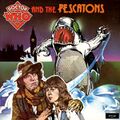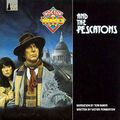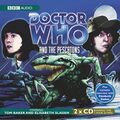Doctor Who and the Pescatons (audio story): Difference between revisions
m (Adding a missing full stop.) Tag: sourceedit |
(2.2 Updated with new information - adding connection to another Pemberton story) Tag: sourceedit |
||
| Line 68: | Line 68: | ||
== Continuity == | == Continuity == | ||
* The plot hinges on the [[Fourth Doctor]] playing the [[piccolo]] "whenever he's nervous." This notion has no basis in any other licensed story. It may have been [[writer]] [[Victor Pemberton]]'s attempt to build a kind of continuity between the [[Fourth Doctor]] and the [[recorder]]-playing [[Second Doctor]], since he was one of the architects of the [[Patrick Troughton]] era. | * The plot hinges on the [[Fourth Doctor]] playing the [[piccolo]] "whenever he's nervous." This notion has no basis in any other licensed story. It may have been [[writer]] [[Victor Pemberton]]'s attempt to build a kind of continuity between the [[Fourth Doctor]] and the [[recorder]]-playing [[Second Doctor]], since he was one of the architects of the [[Patrick Troughton]] era. | ||
* Similarly, [[Victor Pemberton|Pemberton]], also wrote the [[Second Doctor]] story [[TV]]: ''[[Fury from the Deep (TV story)|Fury from the Deep]]'', which also featured an aquatic lifeform that was vulnerable to high-pitched sounds (in that case [[Victoria Waterfield|Victoria's]] screams), and opened with the [[TARDIS]] landing on a deserted beach. | |||
* A scene which once may have played as a "[[Tom Baker]]-ism" now has [[retroactive continuity]] with ''[[A Good Man Goes to War]]'' and ''[[Closing Time (TV story)|Closing Time]]''. At one point, the Doctor and Sarah Jane encounter an abandoned [[baby]] on the streets of [[London]]. The Doctor attempts to talk to him, but flatly says that "he won't talk." Sarah corrects him, saying that "he ''can't'' talk." Since modern listeners know that the [[Eleventh Doctor]] claims to be able to speak "[[Baby (language)|Baby]]," the scene ''now'' plays as though the Doctor's statement is probably more accurate than Sarah's. | * A scene which once may have played as a "[[Tom Baker]]-ism" now has [[retroactive continuity]] with ''[[A Good Man Goes to War]]'' and ''[[Closing Time (TV story)|Closing Time]]''. At one point, the Doctor and Sarah Jane encounter an abandoned [[baby]] on the streets of [[London]]. The Doctor attempts to talk to him, but flatly says that "he won't talk." Sarah corrects him, saying that "he ''can't'' talk." Since modern listeners know that the [[Eleventh Doctor]] claims to be able to speak "[[Baby (language)|Baby]]," the scene ''now'' plays as though the Doctor's statement is probably more accurate than Sarah's. | ||
* The Doctor asks Sarah Jane, "What do you take me for, the [[Pied Piper]] of [[Hamelin]]?" The Doctor met the Pied Piper while in his [[First Doctor|first incarnation]]. ([[COMIC]]: ''[[Challenge of the Piper (comic story)|Challenge of the Piper]]'') Sarah Jane would later encounter the Pied Piper herself in [[2009]]. ([[TV]]: ''[[The Day of the Clown (TV story)|The Day of the Clown]]'') | * The Doctor asks Sarah Jane, "What do you take me for, the [[Pied Piper]] of [[Hamelin]]?" The Doctor met the Pied Piper while in his [[First Doctor|first incarnation]]. ([[COMIC]]: ''[[Challenge of the Piper (comic story)|Challenge of the Piper]]'') Sarah Jane would later encounter the Pied Piper herself in [[2009]]. ([[TV]]: ''[[The Day of the Clown (TV story)|The Day of the Clown]]'') | ||
Revision as of 23:48, 18 November 2015
Doctor Who and the Pescatons was the first original, officially licensed audio drama based upon Doctor Who. Originally released by Argo Records, the story featured Tom Baker and Elisabeth Sladen, as the Fourth Doctor and Sarah Jane Smith. It was divided into two episodes, complete with opening and closing themes, simulating the televised series.
Discounting a couple of radio appearances and an LP version of Genesis of the Daleks with added narration, The Pescatons was the last time that Baker participated in an original Doctor Who audio drama until the Hornets' Nest arc in 2009.
The story was unusual because of its first-person perspective. Though first-person narratives weren't entirely without precedent — the earlier Doctor Who in an Exciting Adventure with the Daleks had been written from Ian Chesterton's point of view — this was the first time that a story had been told from the Doctor's perspective, similar to Big Finish Productions' Companion Chronicles series. Until 2010's Dead Air, it remained the only original story narrated by the Doctor himself.
It was also unusual for its depiction of a genocide devised and led by Sarah and the Doctor, without either character displaying even a tinge of remorse.
Publisher's summary
The Doctor and his companion Sarah Jane battle against some of the most heinous foes to emerge from the outer universe: The Pescatons. The Doctor finds himself in the capital city of London, where the population is bewildered and trembling beneath the violent onslaught of a merciless invader.
Who or what is the mighty Zor, whose green slanting luminous eyes glare out from the dark of night like giant emeralds? What is the powerful alien force that is bringing Earth's civilisation to a standstill, threatening to annihilate everything in its path?
This is the story of a dying Planet, of a Deadly Weed, and the merciless Creatures themselves. It is a Challenge to the Doctor—a frightening race against time...
Plot
Part one
The TARDIS arrives on a beach by the Thames Estuary at night, and the Doctor and Sarah Jane discover a metallic seaweed there.
The Doctor consults with Professor Emerson, who says that three expeditions to recover a recent meteorite from the bottom of the estuary have all vanished. The Doctor goes diving and is nearly killed by something that wraps itself around him, but then lets him go. He discovers that the meteorite is a wrecked spaceship buried under the estuary, and he knows where it comes from
The Doctor tells Sarah Jane about the Pescatons, a form of carcharhinidae, or deep water shark. Naturally, the experts scoff until one comes out of the Thames and makes its way to London Zoo in search of salt water. The Doctor confronts it in the Aquarium, where it dies and disintegrates.
That night, more meteorites land in the Thames.
Part two
London is invaded, and the Doctor recalls his visit to planet Pesca, home of the Pescatons. He fell down a chasm into a cavern and met Zor, the leader of the Pescatons who informed him that they were going to use him to find a new home now that their own planet was drying out as it fell towards their sun. Zor used his hypnotic powers on the Doctor, who fought back and escaped.
Back in London, Sarah Jane finds an abandoned baby while the military try to shoot the invading Pescatons to no avail. The Doctor distracts a Pescaton by singing Hello Dolly and doing a dance so that Sarah Jane can get away with the child. Finally the Pescatons retreated back into salt water, except for one trapped in an Underground tunnel. The Doctor and Sarah Jane go in search of it, and the Doctor starts playing his piccolo to calm his nerves. The Pescaton retreats at the sound.
Professor Emerson helps the Doctor build a high frequency sound trap inside a sewer, and Zor is lured there to be destroyed as the planet Pesca disintegrates in its orbit. Without Zor to control it, the Pescaton invasion ends.
Cast
References
- The Doctor sings "Hello, Dolly!".
Notes
- Doctor Who and the Pescatons was released to capitalise on the success of the Fourth Doctor and Sarah Jane Smith.
- Bill Mitchell (Zor) filmed a scene for TV: Frontier in Space in which he played a 26th century newscaster. While the scene was cut from the televised version of the story, it was included in the novelisation PROSE: Doctor Who and the Space War.
- Unusually, the Doctor here calls the Pescatons "evil" on many occasions. This characterisation of another species is atypical for the Doctor. Indeed, it lays the foundation for another extraordinary feature of the story: the Doctor and Sarah devise and participate in the remorseless genocide of the Pescatons.
Continuity
- The plot hinges on the Fourth Doctor playing the piccolo "whenever he's nervous." This notion has no basis in any other licensed story. It may have been writer Victor Pemberton's attempt to build a kind of continuity between the Fourth Doctor and the recorder-playing Second Doctor, since he was one of the architects of the Patrick Troughton era.
- Similarly, Pemberton, also wrote the Second Doctor story TV: Fury from the Deep, which also featured an aquatic lifeform that was vulnerable to high-pitched sounds (in that case Victoria's screams), and opened with the TARDIS landing on a deserted beach.
- A scene which once may have played as a "Tom Baker-ism" now has retroactive continuity with A Good Man Goes to War and Closing Time. At one point, the Doctor and Sarah Jane encounter an abandoned baby on the streets of London. The Doctor attempts to talk to him, but flatly says that "he won't talk." Sarah corrects him, saying that "he can't talk." Since modern listeners know that the Eleventh Doctor claims to be able to speak "Baby," the scene now plays as though the Doctor's statement is probably more accurate than Sarah's.
- The Doctor asks Sarah Jane, "What do you take me for, the Pied Piper of Hamelin?" The Doctor met the Pied Piper while in his first incarnation. (COMIC: Challenge of the Piper) Sarah Jane would later encounter the Pied Piper herself in 2009. (TV: The Day of the Clown)
Home media releases
This story has been released several times on both cassette and audio CD.
Record release
Argo record release: 1976.
Cassette releases
Audio CD releases
Silva Screen 1991 release
External links
- Doctor Who and the Pescatons at the Doctor Who Reference Guide
- DisContinuity for Doctor Who and the Pescatons at Tetrapyriarbus - The DisContinuity Guide
| |||||||||||||||||||||||||||||||||||||||






